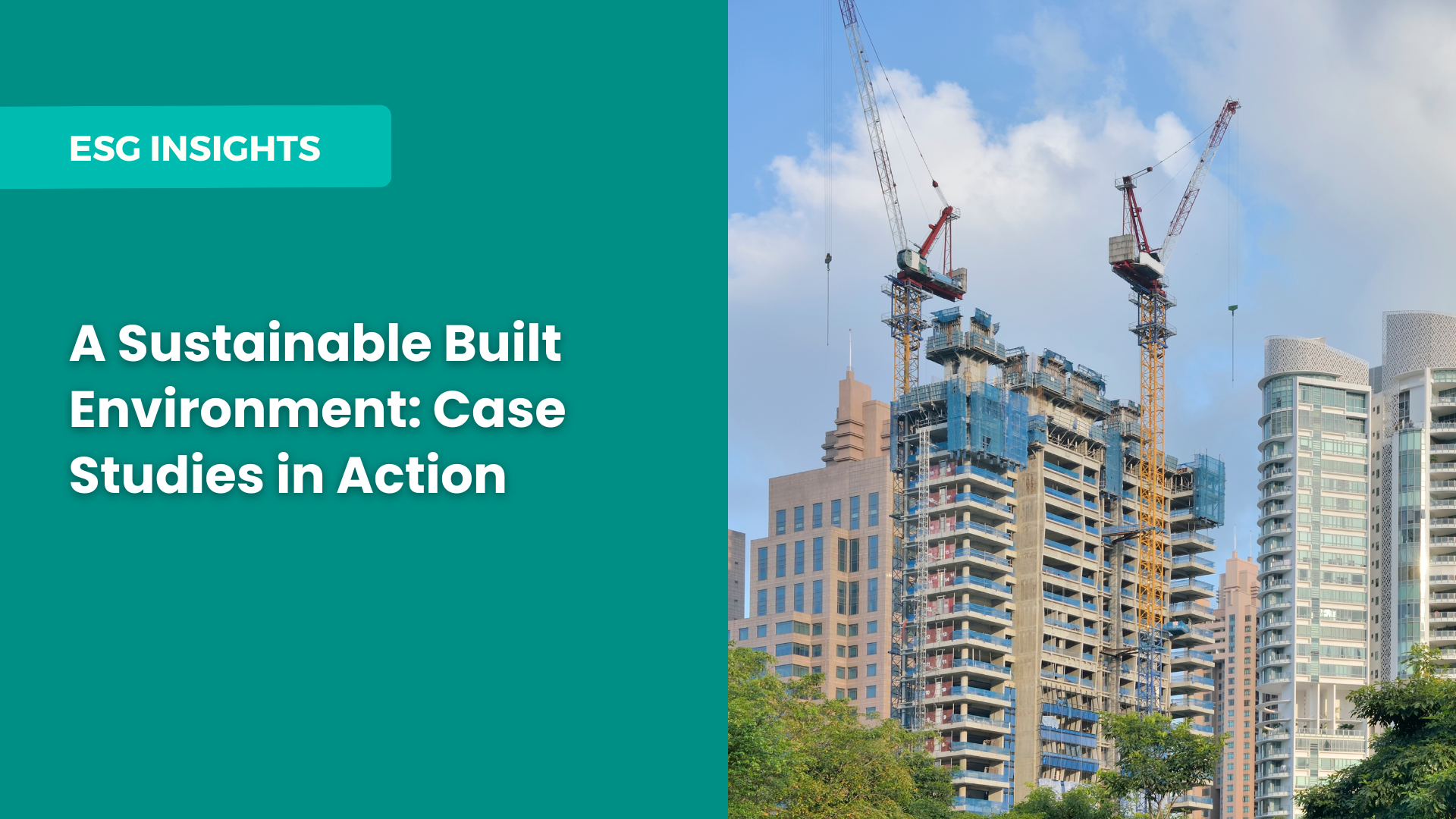Published 21 Jan 2025 –
A sustainable built environment isn’t just good for the planet – it’s increasingly seen as a key driver of profitability for developers, contractors, and investors. Furthermore, the built environment is currently responsible for almost 40% of global energy and process-related CO2 emissions.
Buildings are typically a major source of carbon dioxide emissions due to two main sources – the construction process and heating, cooling, and lighting of buildings.
A significant amount of energy is used in the production, transportation, and installation process of building materials such as steel, aluminium, and cement. The carbon generated from these processes are known as embodied carbon emissions – which typically make up 22% of a building’s emissions.

The built environment contributes a significant proportion of global GHG emissions.
Embodied carbon emissions are often more challenging to address since these emissions are locked into the constructed buildings, with carbon reduction measures coming in way before the building process even begins.
On the other hand, vast amounts of energy are used post-construction for heating, cooling, and lighting of buildings, known as operational carbon emissions.
For buildings to become greener, it is important for businesses to identify and reduce both operational and embodied emissions. On a wider scale, decarbonising the built sector – responsible for almost 30 per cent of global emissions – is crucial towards achieving the Paris Agreement targets of keeping global warming below 2°C.
Increasing Demand for a Sustainable Built Environment
In Asia-Pacific, demand for sustainable office spaces is growing, with 9 in 10 commercial real estate occupiers in Asia targeting 100% green-certified portfolios by 2030. Cities such as Hong Kong, which fall behind in terms of green upgrades, are at risk of losing competitive edge as a business hub in Asia as their neighbours offering greener office spaces gain more attention.
To advance net zero in the built environment, the Green Building Councils (GBCs) in the Asia Pacific region have developed the WorldGBC Asia Pacific Net Zero Readiness Framework to support the building and construction industry on their journey to net zero emissions by 2050.
Green Building Certifications
As the world grapples with a supply and demand mismatch for green buildings and tenants, the pressure is increasingly on industry professionals to create buildings that are not only environmentally friendly but also energy efficient.
National green building certifications are used to evaluate and recognise buildings that meet environmental and sustainability standards, creating benchmarks for other stakeholders to use.
Some examples of built environment certifications include:
- WiredScore and SmartScore Certifications
- Building Research Establishment Environmental Assessment Methodology (BREEAM) Certification
- Leadership in Energy and Environmental Design (LEED) rating system developed by the United States Green Building Council
- Global Real Estate Sustainability Benchmark (GRESB)
- Concrete Sustainability Council (CSC)
- Thai’s Rating of Energy and Environmental Sustainability (TREES) developed by the Thai Green Building Institute (TGBI)
- GREENSHIP Certification developed by the Green Building Council Indonesia
- Green Star developed by the Green Building Council Australia, adapted for use in New Zealand as well
- Green Mark Certification Scheme developed by the Building and Construction Authority Singapore
Architects who are responsible for the design of buildings play a key role in creating buildings which qualify for these green ratings – by integrating sustainable design principles into as many aspects of the project as possible.
This includes choosing sustainable design options for design aspects such as lighting, cooling, heating systems, and materials, and ultimately planning with green certification requirements in mind for the building to meet high sustainability standards such as LEED and BREEAMS.
After the planning is completed, developers and contractors take over the key role of installing and executing the sustainable designs accordingly, with a key responsibility to ensure that construction methods and materials sourced are environmentally friendly.
Growing Sustainability Criteria for the Built Environment
Authorities are beginning to impose more stringent sustainability criteria for developers and contractors, making a compelling case for many to kickstart their carbon reduction efforts.

BCA’s Introduction of Environmental Sustainability Criteria in Quality Component of the Price Quality Method (PQM) Framework.
These measures include sustainability criteria in tender evaluations for government projects from 2024 in a bid to green supply chains. For instance, the Building and Construction Authority (BCA) in Singapore has advanced legislation on environmental sustainability for buildings, starting with tenders.
For larger construction tenders with estimated construction costs above S$50 million, developers and contractors must showcase their sustainability credentials, taking effect after 31 January 2025.
Developers and contractors are responsible for ensuring such environmental sustainability criteria are met in the construction process of the project, an occurrence likely to happen in more jurisdictions across Asia Pacific in the coming years.
As green certification and credentials for buildings shift from being a differentiator to being a requirement, developers, contractors, building owners, and occupants are more willing to invest in measures to build sustainably as a strategic business decision.
Benefits of Greening Buildings for Developers, Contractors, and Investors
Apart from reducing GHG emissions as part of working towards net zero emissions globally, there have been proven benefits for developers, contractors, investors, and building owners in adopting sustainable building practices.
Green buildings have been associated with overall cost savings, and premium asset value, leading to an efficient recuperation of investments in the long term.
- Long-term savings in Design and Construction Costs
- Eco-friendly construction materials, such as bamboo flooring, are central to sustainable building design. Though some of these materials may come at a higher upfront cost, they often lead to long-term savings due to their efficiency and durability.
- For example, recycled steel reduces the demand for newly mined materials, is equally as durable as newly mined steel, and is cheaper with a lightweight quality which equates to less use of heavyweight equipment.
- Lower Operational Cost
- Reduced energy and water consumption are some of the benefits of retrofitting buildings with efficient appliances and have shown to save money by lowering long-term operations and maintenance costs.
- Higher Asset Value
- Buildings with better sustainability credentials have seen increasing marketability, with 74% of organisations being willing to pay a premium for leasing a building with leading sustainability or green credentials.
Greening the built environment has increasingly been linked with economic benefits and opportunities, with more incentives for stakeholders to adopt green practices despite some initial premiums.
Challenges in Decarbonising the Built Environment
Given the scale and complexity of the designing, planning, and construction process, decarbonising the built environment comes with its own set of unique challenges.
Whole Life-Cycle Carbon (WLC) emissions are the carbon emissions resulting from materials, construction, and operations over a building’s entire life, including demolition and disposal.
Challenges involved in reducing operational carbon emissions:
- Costliness of green retrofits
- Building structure as a limiting factor
- Limited knowledge of energy efficient appliances and technology
Although much attention has been placed on operational carbon emissions – with measures in place such as energy efficiency improvements and refurbishments of existing buildings being done, there is an urgent need to address embodied carbon emissions.
While operational carbon can be actively reduced over time, embodied carbon emissions are more challenging to tackle as they occur upfront from the moment the building materials are produced.
Challenges involved in reducing embodied carbon emissions:
- Lack of standardised baselines for embodied carbon measurements
- Difficulties in gaining access to supply chain data and relevant Emission Factors (EFs)
- Complex supply chains involving resource-strapped SMEs who have limited resources to kickstart carbon calculations and reporting
ESGpedia Use Cases: A Sustainable Built Environment
Developers and contractors have leveraged ESGpedia’s digital solutions such as our Sustainability Reporting Portal, Supplier/Contractor Engagement Module, and GHG (Greenhouse Gas) Emissions Calculator to advance on their sustainability journey and stay ahead of regulations.
Building Carbon Accounting and ESG Reporting Capacity with Developers and Contractors | City Development Limited’s Queen Bee Supplier Program
ESGpedia is the carbon accounting and reporting partner of City Development Limited (CDL)’s Queen Bee Supplier Program, in collaboration with Global Green Connect and DBS Bank, supported by Enterprise Singapore.
The program aims to empower SME suppliers in carbon accounting and reporting, building carbon reduction capacity to ensure good standing. SMEs who build strong decarbonisation commitments and targets can become preferred suppliers to both CDL and other companies who are seeking to green their supply chains.
Contractor/Supply Chain Engagement on ESGpedia
Developers and main contractors will be able to onboard subcontractors to the ESGpedia platform to calculate their carbon emissions easily and account for their embodied emissions.
Through the program, eligible contractors/suppliers can also expect to receive up to 70% funding until 30 November 2025.
Read more about CDL’s Queen Bee Supplier Program here.
Empowering Subcontractors to Calculate Carbon Emissions | Kimly Construction Pte Ltd Use Case
ESGpedia has enabled Kimly Construction Pte Ltd to actively engage their subcontractors to embark on their own sustainability journeys, starting with obtaining relevant data and calculating their emissions.
Co-branded portals to engage Subcontractors on taking the first step to sustainability
The co-branded portal kimly.esgpedia.io enables Kimly Construction to streamline the process and engage subcontractors from onboarding, data collection, monitoring, analysing, and taking action.
Hosting Sustainable Workshops for Supply Chain Partners
Earlier this year, our team was also invited to share our insights on engaging supply chain partners in sustainability efforts at Kimly Construction Pte Ltd’s first Sustainability Day.
Through such workshops and efforts, ESGpedia continues to work with developers, main contractors, subcontractors, and suppliers to level the playing field for stakeholders, enabling them to stay competitive and thrive amidst upcoming sustainability criteria in tenders.
Enabling Contractors to Calculate Embodied Carbon Emissions for Office Refurbishment Project | Ngai Chin Construction Pte Ltd Use Case
In Ngai Chin Construction’s recent refurbishment project for a large corporate entity, ESGpedia stepped in to help Ngai Chin, as a main contractor, calculate the embodied emissions of the project via our platform.
In order to report the full environmental impact of the international corporation’s office refurbishment project, emissions from the process such as furniture and fittings disposed, recycled or reused materials, diesel, petrol consumption or machinery, equipment, transport, electricity used, and raw materials of new furniture and fittings were calculated compiled into a comprehensive Project-level GHG Emissions Report for Ngai Chin and the corporation to showcase to relevant stakeholders.
Project-Level GHG Emissions Calculation and Report on ESGpedia
Emission calculations were done using seamless emission factor matching within the ESGpedia platform and existing Environmental Product Declarations (EPDs) to ensure efficient and accurate carbon footprint assessments.
ESGpedia will continue to work closely with Ngai Chin on subcontractor engagement – to account for future projects’ full embodied carbon emissions including fuel and electricity consumption.
Streamlining Green Trade Finance for the Built Environment | SGTraDex, Building and Construction Authority (BCA) of Singapore, UOB Bank and Singapore Institute of Technology (SIT) Use Case
In a partnership with SGTraDex and the Building and Construction Authority (BCA) of Singapore, ESGpedia has successfully empowered UOB in a successful pilot to obtain green certification data for the new Punggol Campus of Singapore Institute of Technology (SIT).
In enabling a digital and traceable workflow, the friction faced by banks in accessing green data and credentials in the built environment ecosystem for evaluating Green and Sustainable Trade Finance is reduced, particularly during the construction phase.
End-to-end Digital Solutions for a Sustainable Built Environment
Embodied Carbon Footprint Calculator
-
- ESGpedia’s carbon calculator is built in accordance with the GHG Protocol and ISO14064-1, aligned with international standards and localised to all Asia-Pacific countries.
- Calculate Scope 1, 2, and 3 emissions including specific material emissions such as concrete, aluminium, steel, and other building materials

Bulk calculation of various construction materials using specific emission factors from relevant sources on ESGpedia.
- Calculated embodied and operational carbon emissions, swiftly generate embodied carbon and project-level ESG, GHG, or sustainability reports, and assess the environmental impact of your project.
-
- Streamline and actively engage subcontractors from data collection, to monitoring, analysing, and taking action through a single platform.
-
- Go beyond calculating and reporting their emissions to take further action and get connected with assurance and advisory partners, carbon offsets, green procurement, green certification, sustainable financing, and more.
-
- Companies can take their first steps towards sustainability reporting by reporting metrics that are aligned with stakeholders’ needs, including project-level emissions, and demonstrate their commitment to sustainability.
- Sign up to attain your ESBN Green Deal Badge
Profiting from Sustainability: Green Measures for a Sustainable Built Environment
As regulatory requirements develop across various jurisdictions and increase in prevalence in the built sector, it is crucial for companies to begin and accelerate sustainability efforts to remain competitive and thrive.
ESGpedia’s end-to-end digital platform enables companies to leverage sustainability criteria and gain an edge to win more tenders in today’s increasingly competitive landscape.
Get in touch to kickstart your green transition.




